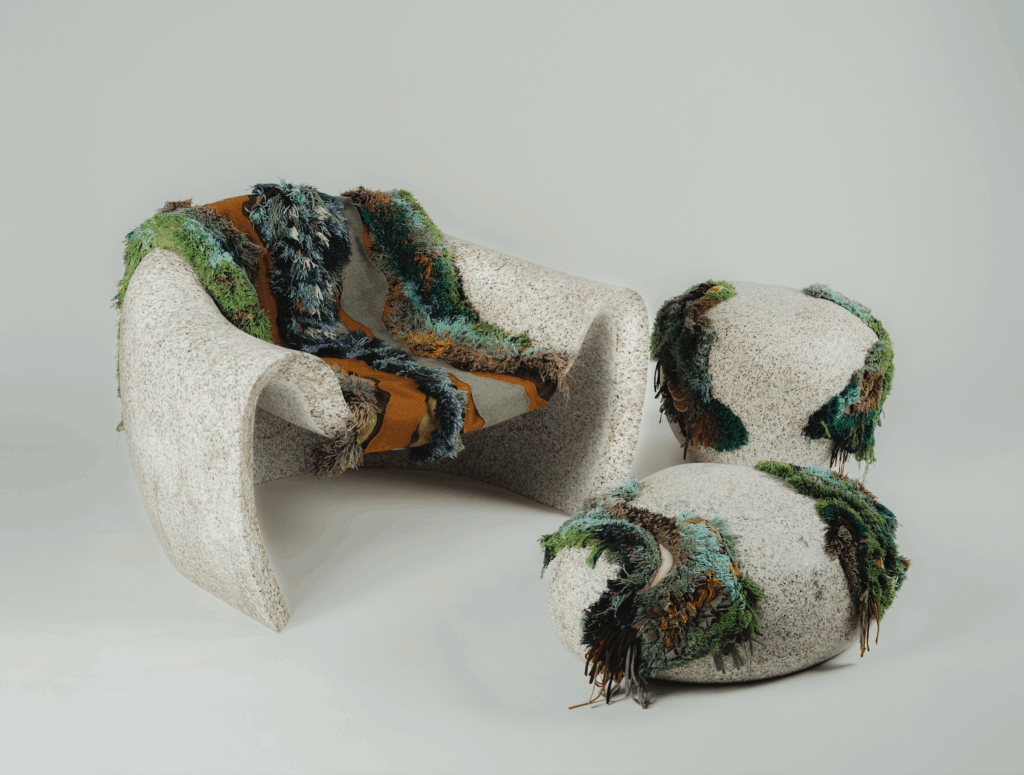
Created using mycelium, Reishi features the inherent strength and hand-feel of premium leather. But don’t mistake this biomaterial for other plant-based options. “It is not made by assembling ingredients, shaving them, and putting them on a backing,” says Frederick Martel, MycoWorks’ SVP of sales and brand development, about how mushroom leather is produced. And unlike some vegan leathers, which can have a high plastic content, Reishi can be specified with little or none of the latter material. “It’s a mix of art and science,” says Martel of the formulation.
Indeed: After studying how the mycelium root system works, the MycoWorks team developed a proprietary Fine Mycelium technology whereby the material grows in trays from scratch. During the process, the company “tunes” the material to have whatever thickness and surface attributes the client desires. Then it harvests the material in sheets and finishes it in tanneries, just like regular leather. “It’s a very natural material,” Martel says of the result. “You get the emotion that leather conveys, the patina, and the suppleness, but it is more sustainable.”
Reishi has the emotion, patina, and suppleness of leather, but is far more sustainable to produce.
Heritage tanneries in Europe use MycoWorks’ chrome-free tanning and dying technologies to finish the products, which are available in three textures: Natural, Doux, and Pebble. The material, which is inherently fire-resistant and anti-bacterial due to its biological composition, also can be made to be water-repellent.

After the Fine Mycelium fermentation process, two materials are left: a Reishi sheet and this composite brick.
The groundwork for Reishi began in the 90s, when artist and MycoWorks co-founder Philip Ross began cultivating mycelium as a material for his sculpture projects. After he presented panels of it at the 2016 Venice Biennale of Architecture, architects and manufacturers began asking if he could create a more flexible and supple version of the then-rigid material. Thus, he began developing the Fine Mycelium platform and its flagship product, Reishi.
Small-batch work with luxury fashion brands soon followed, among them Hermes and YUME YUME. However, with its new commercial-scale facility in Union, South Carolina, which opened in October 2023, MycoWorks has gained the production capacity to move into new industries.
GM Ventures, the venture capital arm of American car manufacturer General Motors, has invested in MycoWorks with the aim to use the technology to create an alternative to the animal leather used in car interiors. Ligne Roset, the high-end French furniture company, has also partnered with MycoWorks to launch a series of products upholstered in Reishi. Items from the latter will be available worldwide, with a preview at ICFF.
Martel thinks the time is ripe for MycoWorks to move into the design industry. “By first making smaller goods, such as handbags, we were able to validate two points,” he says. “That we had the level of quality we wanted, and that it met the standards of the end consumer.”
Ligne Roset is also the ideal partner, he feels, because both companies have similar values. “It was clear to us from the beginning that you can’t pit quality against sustainability: You have to have both,” he says. “And [Ligne Roset CEO Antoine Roset] shares the same philosophy. So, we are extremely happy to be working with them.”
Although the Fine Mycelium technology can be pushed however desired to serve the functional and aesthetic needs of its end users, Martel wants to make one thing clear about Reishi. “It is not a replacement for leather or pleather,” he says, “but rather a completely new material.”
Frederick Martel will be a panelist for Reishi: An Environmentally Friendly Material for Scalable Design, a talk that will take place Monday, May 20, 3:00-3:30 on the Oasis Stage.





